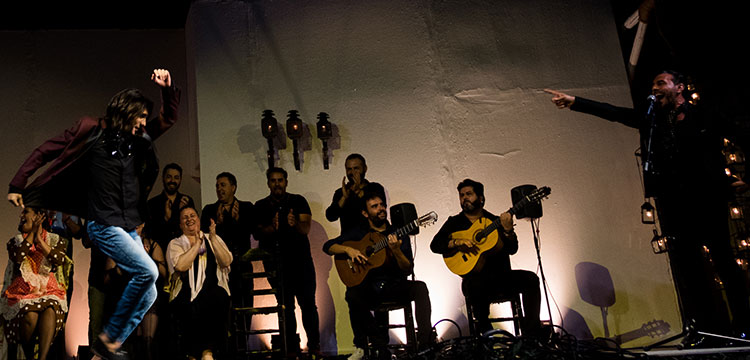50th Reunión de Cante Jondo
Saturday, July 7th, 2018. 11:00pm
La Puebla de Cazalla, Hacienda La Fuenlonguilla
Text: Estela Zatania
Photos: Tamara Pastora
“It’s unlikely that’s going to end” José María Moreno Galván, 1968
Voice: La Yiya, Duquende, Elu de Jerez, Pedro el Granaíno. Solo guitar: Dani de Morón. Accompaniment guitars: Antonio García, Antonio Higuero, Patrocinio Hijo. Dance: Antonio el Pipa with the singing of Morenito de Íllora, Carmen and Gema Cantarota, guitars of Juan José Alba and Javier Ibáñez. Pastora Galván with the singing of Manuel Tañé and Jeromo Segura, the guitar of Juan Requena and rhythm of Bobote. Master of ceremonies: Juan José Téllez.
On Saturday night, July 7th, 2018, another historic flamenco event claimed its rightful place in the half-century club. The above-cited words of José María Moreno Galván, elder brother of Francisco Moreno Galván (who today would be defined as a “flamenco mover and shaker”), referring to the possible disappearance of “cante jondo”, now, on the 50th anniversary of the Reunión de Cante Jondo de La Puebla de Cazalla, provoke little more than a withering smile on the lips of the new generation.
Let’s look at the chronology… In 1968, “El Camarón de la Isla con la Colaboración Especial de Paco de Lucía”, the historic recording flamenco fans know as “Al Verte las Flores Lloran”, wouldn’t be recorded until one year later, meaning the revolutionary duo was practically unknown. We listened to Antonio Mairena on the radio, although the term “mairenism” wasn’t in circulation, nor any of its associated negative connotations. The maestro for us young flamencos was Antonio Fernández “Fosforito”, along with other admirable interpreters such as Terremoto de Jerez, Manolo Caracol, el Chocolate and Fernanda and Bernarda de Utrera among others. The name of Enrique Morente began to be mentioned more frequently, and veteran singer Pepe Marchena was still current. How could anyone think flamenco was going to disappear!
Last night, all those memories and ghosts were in attendance one way or another, witnesses of a heart-felt celebration of the triumph of flamenco. Has anything been lost? That question, and its corresponding answer, must be worked out by each individual. Generally speaking, it was a relatively discreet program compared with other editions. In addition to the passing two years ago of José Menese, the most representative singer of La Reunión, the beloved veteran Diego Clavel was sorely missed. Also absent was the much-admired “house guitarist” Antonio Carrión, although he did participate in two recitals on previous days associated with the festival.
Young guitarist Dani de Morón, opened the program with soleá, and after intermission, siguiriyas, with his hybrid sound covering contemporary, classic and everything in between, which he knows and executes with command and knowledge. Elegant local singer Ana Ramírez “La Yiya”, with the interesting guitarist Antonio García, defended the La Puebla school of flamenco singing, remembering Menese again and again with her voice of honey and lemon. In siguiriyas, she successfully represented the contained cry Clavel does so well.
With four solo singers on the program, two of them were repeaters so to speak of the Camarón signal, although Duquende and Pedro el Granaíno have personalities of their own. The former sang mining cante, soleá por bulería, tangos and bulerías with the accompaniment of Dani de Moron, and without actually being the prototype singer appreciated in La Puebla, he earned the audience’s appreciation. El Granaíno with Patrocinio Hijo on guitar applied his warm textured voice to a series of stylized forms, showing the security acquired from having sung for dance.
Eloísa Jiménez, “Elu de Jerez”, brought intravenous Jerez and some superb moments of siguiriyas dedicated “to the memoryof Menese”, with the hot guitar of Antonio Higuero.
Two dance groups filled out the program. In the first part, Antonio el Pipa, for the fifth time at the Reunión. He is the eternal dandy, now artistically mature, with the fine singing of Morenito de Íllora, in addition to Carmen and Gema Cantarota and the guitars of Juan José Alba and Javier Ibáñez. And in the second part, Pastora Galván gave us her traditional dancing with that touch of instability she does so well, with great backup musicians: singers Manuel Tañé and Jeromo Segura, the guitar of Juan Requena and the multi-purpose Bobote.
Pastora spoke to the audience to express her desire to pay tribute to José Menese via the “marianas” form he often interpreted. All this, and there was still the round of tonás, the fiesta finale with nearly all the artists and ready, set, go for the next half century that begins today.
Photo gallery – Tamara Marbán Gil (full photo gallery)
